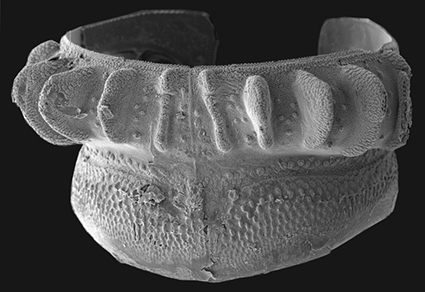Abstract
Two new genera and species, Stegostriaria dulcidormus (Trisariinae) and Kentrostriaria ohara (Striariinae), are described from Oregon and Idaho, respectively. The new species are distinct from any other striariids, and indeed from any other chordeumatidan millipedes, in having the second dorsal crests greatly enlarged, giving them a fanciful resemblance to stegosaurid dinosaurs. In spite of this similarity, the two species are so distinct they cannot be accommodated in the same genus or the same subfamily. The exaggerated metazonital crests are therefore attributed to convergent evolution. We present a key to the genera of the family Striariidae.
References
Bollman, C.H. (1888) Notes upon a collection of Myriapoda from East Tennessee, with a description of a new genus and six new species. Annals of the New York Academy of Sciences, 4, 106–112. https://doi.org/10.1111/j.1749-6632.1889.tb57035.x
Bollman, C.H. (1893) The Myriapoda of the United States. United States National Museum Bulletin, 43, 1–210.
Bond, J.E., Godwin, R.L., Colby, J.D., Newton, L.G., Zahnle, X.J., Agnarsson, I., Hamilton, C.A. & Kuntner, M. (2021) Improving taxonomic practices and enhancing its extensibility–an example from Araneology. Diversity, 14, 1–15. https://doi.org/10.3390/d14010005
Chamberlin, R.V. (1941) New Western millipeds. Bulletin of the University of Utah, 31 (2), Biological Series, 6, 3–23.
Hennig, E. (1915) Kentrosaurus aethiopicus, der Stegosauridae das Tendaguru. Sitzungberichte der Gesellschaft Naturforschender Freunde zu Berlin, 1915, 219–247.
Kemperman, T. & Gittenberger, E. (1988) On morphology, function and taxonomic importance of the shell ribs in Clausiliidae (Mollusca: Gastropoda: Pulmonata) with special reference to those in Albinaria. Basteria, 52, 77–100. [https://natuurtijdschriften.nl/pub/596881]
Marsh, O.C. (1877) A new order of extinct Reptilia (Stegosauria) from the Jurassic of the Rocky Mountains. American Journal of Science, 3, 513–514. https://doi.org/10.2475/ajs.s3-14.84.513
Shear, W.A. (1973) Millipeds from Mexican and Guatamalan caves. Accademia Nazionale dei Lincei, Problemi attuali di scienza e di cultura, 171, 239–305.
Shear, W.A. (2020) The millipede family Striariidae Bollman, 1893. I. Introduction to the family, synonymy of Vaferaria Causey with Amplaria Chamberlin, the new subfamily Trisariinae, the new genus Trisaria, and three new species (Diplopoda, Chordeumatida, Striarioidea). Zootaxa, 4758 (2), 275–295. https://doi.org/10.11646/zootaxa.3109.1.1
Shear, W.A. (2021a) The millipede family Striariidae Bollman, 1893. II. New records and species of the genus Amplaria Chamberlin, 1941 (Diplopoda, Chordeumatida, Striarioidea). Zootaxa, 4908 (2), 205–224. https://doi.org/10.11646/zootaxa.4908.2.3
Shear, W.A. (2021b) The millipede family Striariidae Bollman, 1893. III. Four new species of Striaria Bollman, 1888 (Diplopoda, Chordeumatida, Striarioidea). Zootaxa, 4920 (3), 395–406. https://doi.org/10.11646/zootaxa.4920.3.5


